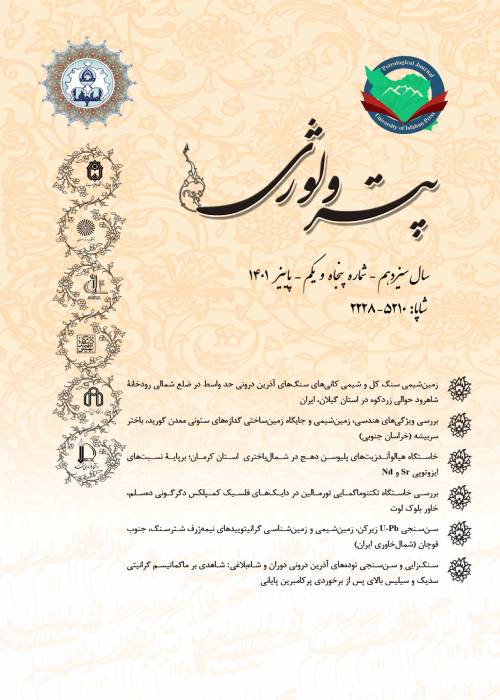Evolution of ore- forming fluids in Dashkasan gold deposit, NE Qorveh, West of Iran, based on tourmaline chemical composition and fluid inclusion data
Tourmaline is a borosilicate mineral with general formula of XY3Z6[T6O18](BO3)3V3W. Experimental studies demonstrate a wide range of stability for tourmaline-supergroup minerals to record different geological processes. They occur in metamorphic, granitic pegmatites, and clastic sedimentary rocks and are associated with hydrothermal activities (Dutrow and Henry, 2011; Slack and Trumbull, 2011). Textural and compositional features of tourmaline can be used as an indicator of environment in which it crystallized. Tourmaline from porphyry deposits generally show a. frequently crystal zoning, b. development from Fe-rich to Mg-rich, and c. total Mg content is ~2 apfu in copper deposits and 1-2 apfu in Au deposits (Baksheev et al., 2012). It is believed that the world-class Dashkasan gold deposit records the transformation of porphyry to low-sulfide epithermal (Richards et al., 2006). The Dashkasan gold deposit located in the Kurdistan Province can be a significant region for better understanding the origin and the evolution of ore-forming fluids using chemistry of tourmaline. For the present study, we also tried to apply fluid inclusions data on quartz-tourmaline-pyrite veins from the Dashkasan deposit.
Polished-thin sections of various tourmalines of the Dashkasan deposit were examined using a Cameca SX100 Electron Probe Micro Analysis (EPMA) at the Iran Mineral Processing Research Center, Karaj. Fluid inclusion studies were performed on quartz crystals of quartz-tourmaline-pyrite veins. The microthermometric parametes of fluid inclsions were measured by Linkam-THMS-600 stage at the University of Isfahan.
The Dashkasan gold deposit with 52 Mt of oxidized ore and average grades of 1.77 g/t Au is hosted by the Middle-Miocene porphyritic dacite/rhyodacite and dacitic breccia rocks. The main minerals are quartz, K-feldspar, hornblende and biotite mainly altered.. This deposit is characterized by the transition from the porphyry to the epidermal system with the presence of tourmaline minerals in phyllic and silicification alteration associated with gold veins. As petrographic examination shows tourmaline occurs as disseminated, vein/veinlet, and breccia textures in three types: Tur-1 occurred as needle shape in dacitic rocks associated with phyllic alteration; Tur-2 crystallized as radial shape mainly coexisting with silicification; and Tur-3 with elongated shape is present in dacitic breccia with phyllic alteration.
Mineral Chemistry:
The geochemical composition of three types tourmalines points to the nature and the evolution of ore-forming fluids. Electron microprobe analyses of the studied tourmalines indicate that the Tur-1 and Tur-3 are dravite, and the Tur-2 is dravite to schorl in composition and they belong to alkaline group. The third type, unlike the other two, is characterized by poor zoning and higher values of Na, K, Fe, Mg and lower values of Ca. On Fetot-Ca-Mg ternary diagram, they plotted in the Ca-poor metapelites, metapsammites, and quartz-tourmaline rocks host. Magmatic genesis inferred from the higher Fe/(Fe+Mg) ratio for Tur-1 and Tur-2, while this ratio in the Tur-3 is different and shifted towards hydrothermal source.
Microthermometric Study:
Richards et al. (2006) present the fluid inclusion assemblages from quartz-tourmaline veins in sericitized wall rocks in the Dashkasan deposit consisting of hypersaline and rare vapor-rich inclusion. They have homogenization temperatures of 246° to 360 ℃, yielding salinities of 34.4 to 46.1 wt% NaCl equiv. (Richards et al., 2006). Fluids inclusions studies on quartz-tourmaline-pyrite veins related to transition between stage-1 and stage-2 of mineralization in the Dashkasan shows a salinity values from 15.9 to 16.8 wt% NaCl equiv. and homogenization temperature values between 185° to 254 °C.
On the basis of optical and scanning electron microscopy, three tourmaline types(Turs -1,-2 and -3) in the Dashkasan deposit, can be distinguished. Despite the lack of zoning in Tur-1 and Tur-2, the third type displays the poor zoning. The first-and the third-types of tourmalines are dravite (Mg-rich), whereas the second-type is dravite to schorl in composition. Magmatic genesis is reflected by higher Ʃ(Fe+Mg) and FeO/(MgO+FeO) ratios for the first two types. While these ratios in the Tur-3 is different and shifted toward hydrothermal source. To sum up, the occurrence of quartz-tourmaline-pyrite veins in the Dashkasan deposit is due to the existence of a fault system under the physicochemical performance of the ore-mineralized fluid by a sudden depressurization and probably gradual mixing with shallow water.
- حق عضویت دریافتی صرف حمایت از نشریات عضو و نگهداری، تکمیل و توسعه مگیران میشود.
- پرداخت حق اشتراک و دانلود مقالات اجازه بازنشر آن در سایر رسانههای چاپی و دیجیتال را به کاربر نمیدهد.


